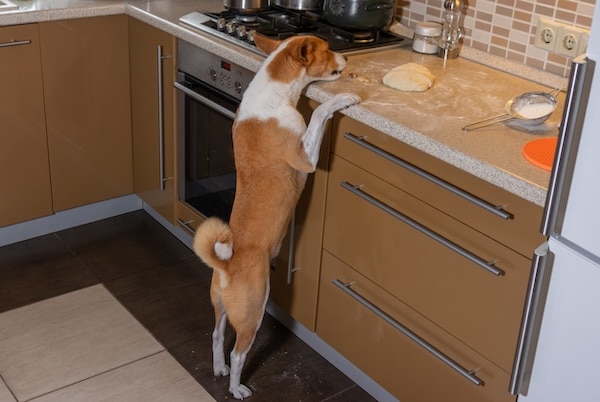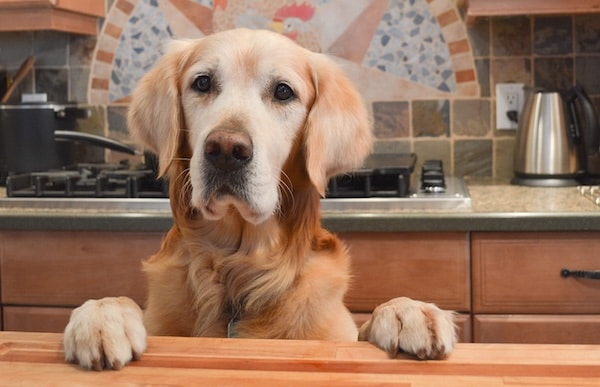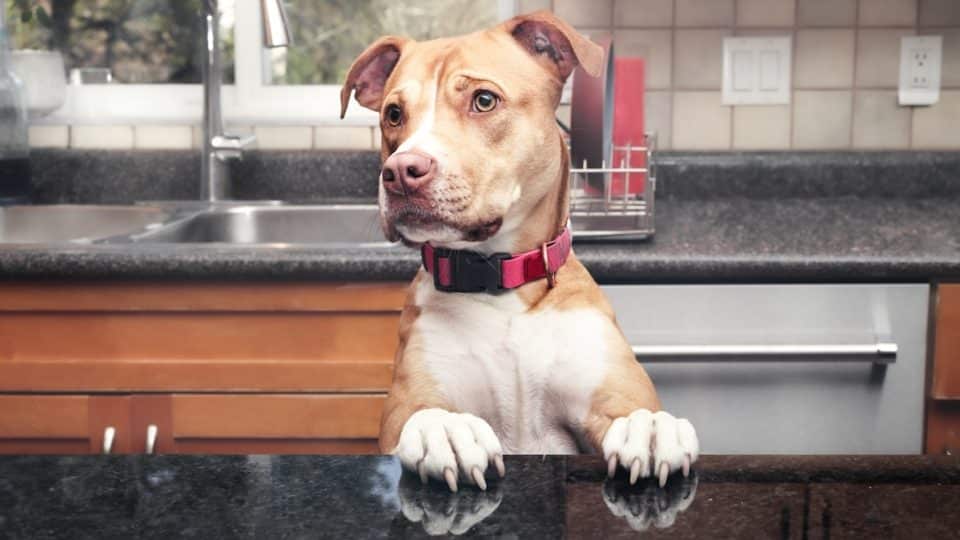- Not a substitute for professional veterinary help.
Some dogs can’t resist the opportunity to skim kitchen counters or jump on tables for goodies. But dog counter surfing isn’t just a bad habit—it can also be dangerous. Certain food and items in your kitchen can harm your pup, and your dog could also get injured trying to reach them.
The trouble is that counters can be hard to dog-proof. A big dog might place their paws on the counter for access to the surface. Agile pups can hop right up, while smaller dogs may use a stool, chair, or drawer to boost them onto the counter. And once counter surfing starts, it’s a self-rewarding behavior—meaning your dog is likely to do more of it.
To learn more about why dogs counter surf and how to curb the habit, we spoke with jme Thomas, certified animal welfare administrator and founder of Motley Zoo animal rescue. Here’s what we discovered.
How To Keep Dogs Off Counters via Management
According to Thomas, the first step to stopping counter surfing is to minimize your pup’s opportunity to do it. By implementing management, you can prevent your dog from repeating and reinforcing the behavior. Here are a few ideas.
- Block access. Put up a physical barrier, like a dog gate, to keep your counter-surfing pup out of the kitchen indefinitely or when there are more chances for temptation, like when you’re cooking. “They will be less likely to be tempted when not given the chance to make a bad choice,” says Thomas.
- Keep food off the counter. Store any edible items in containers and inside cabinets, preferably out of sight, out of reach, and out of scent.
- Use a leash. If you need to keep your dog in the kitchen with you (perhaps you have a young pup in the throes of potty training) or you can’t block off access, attach a leash they can drag around the house. Having your pup on a leash can help you gently guide them away from mischief.
- Redirect them. Any time you see your dog about to counter surf, use a positive interrupter to get their attention. That might mean making a kissy noise and tossing a tasty treat away from the counter. You can also call their name or ask them to do a familiar cue or trick and then reward them generously.
- Use a crate. Crate training is an excellent way to keep an unsupervised dog—and your counters—safe. Once your pup is comfortable being in the crate, you can pop them inside (maybe with a yummy stuffed KONG) during dinner or when you can’t keep a close eye on them.

Yurikr via iStock
How To Stop Counter Surfing: Training Tips
Once you’ve found ways to prevent your dog from rehearsing the self-rewarding behavior of counter surfing, you can start teaching them what you’d rather they do instead. Here are different training methods to try.
Teach an auto sit
The best way to keep dogs off counters is to teach them an alternative behavior. One simple way to do this is by practicing auto sits. These are sits that your dog does without having to be told. They’re super easy to teach, too.
Toss a treat to get your pup to stand up and move away from the counter. When they come back, wait for them to sit (dogs will do this naturally) and then mark the sit with a clicker or verbal marker (like a “yes!”) and give them a treat. Practice this over and over again until your pup understands that sitting is what gets them paid—not jumping on the countertops.
Train an auto leave it
Similarly, you can teach your dog to automatically “leave it” without using a verbal cue. Essentially, the “it,” or the thing on the counter that your dog wants, will become the cue to come to you instead. You can teach this by using the engage-disengage protocol.
You’ll start off by putting an item of interest on the counter while keeping your dog on a leash a few feet away. Once your pup notices the enticing thing on the counter, you’ll click or use your verbal marker and give a treat (feeding away from the counter). This is step one.
After your pup starts expecting the treat to come as soon as they spot the tempting item on the counter, begin waiting for them to look at the object and then look at you. As soon as they do this, mark and reward generously. This is step two.
Once you get to this level, start closing in your distance and upping the ante with more tempting items. Eventually, your pup will learn that exciting things on the counter mean to come find you instead.
Capture preferred behaviors
Another simple training method is to capture and reward any behaviors your dog does throughout the day that aren’t counter surfing. This could be standing near an exciting item, sitting, lying down, relaxing, leaving the room, grabbing a toy instead, etc. Two go-to protocols for this method are Emily Larlham’s Capturing Calmness and Kathy Sdao’s Smart x50.
Teach place
Place training teaches your dog to go to a specific spot—like a bed, mat, or crate—and chill out there for a while.
“Anything can become ‘place,'” says Thomas, so think about where your pup naturally likes to relax when setting things up. “My own dog will go to place the minute we get the plates out and sit down to eat—and if she hesitates, we will tell her and point,” says Thomas. “She knows that the rewards and treats come when she’s in place—and she will wait there patiently until we provide!”
In addition to counter surfing, Thomas says teaching place helps curb other unwanted behaviors like door dashing, jumping on guests and begging for food. It can also help dogs settle in public spaces, like restaurants with dog-friendly patios.
Train boundaries in the kitchen
If you want to keep your dog completely out of the kitchen, you can work on boundary training. Heads-up, though, this method requires a lot of time and consistency and can take weeks or months to solidify.
To get started, you’ll want to always block off access to the kitchen until your dog learns that it’s off-limits. For training, start by keeping your dog on a leash. Walk with them to the kitchen entryway. Just before you get to the kitchen, stop. When your dog stops, too, reward them and move away from the doorway.
Once your dog starts stopping on their own at the entryway, take a few steps inside while they remain standing or sitting outside the kitchen. Reward them for staying in place.
When your pup is successful at this, you can increase the difficulty by working on the three Ds: distance (walking farther away from them), duration (spending more time in the kitchen while they’re outside), and distractions (add more people inside the kitchen or place exciting things on the counter).

LucBrousseau via iStock
Why Do Dogs Counter Surf? FAQs
Counter surfing is dangerous for dogs because they can access human food that’s toxic for them to eat. But counter surfing isn’t always about getting to the tasty snacks. Your dog might be trying to reach some fun, chewy object that they could choke on without your supervision, like a dish towel or piece of cardboard.
Not to mention that your dog could injure themselves trying to jump up on the counters, or that it could lead to more scavenging behavior. “[Counter surfing] could lead to other habits like dumpster diving into your garbage, which can have disastrous results,” says Thomas.
Here’s some more insight into common concerns about counter surfing.
What causes dogs to counter surf?
“Dogs will counter surf most often when something they just can’t resist is available just out of sight—but not out of scent’s reach,” she adds. “This has less to do with being hungry itself and more to do with opportunity and the chance for something special and tasty that they have perhaps never tasted before.”
Why is my dog suddenly counter surfing?
Chances are that even the most well-behaved dog—especially a food-motivated one—might seize a moment to finally get to something they want. Perhaps they were once too small and now are big enough to reach the counter. Or maybe they have tried (unbeknownst to you) and hadn’t been successful on the previous attempts. “The real question is have you left them alone with temptation and provided them the chance to access something they should not?” asks Thomas.
Does negative reinforcement work for counter surfing?
Aversive training techniques, like using shock and prong collars, are more likely to stress your dog and make them act out of fear. Dogs are also very sensitive to sound, so yelling at them or making loud noises is likely to scare them.
While aversive devices like e-collars can curb counter surfing, they’re just suppressing the behavior instead of getting to the root cause. This can produce other negative behaviors as your dogs try to find other ways to cope with the discomfort. It can also deeply damage the relationship you have with your pup.
Are there any products that can help with counter surfing?
Along with using dog gates and leashes, Thomas says you can try using double-sided tape (or tape looped around on itself) along the top edge of the counter. Similarly, you can put aluminum foil on the edges and surfaces of countertops—the texture and sound may be unpleasant enough that a few times is enough for your dog to decide this isn’t rewarding.



